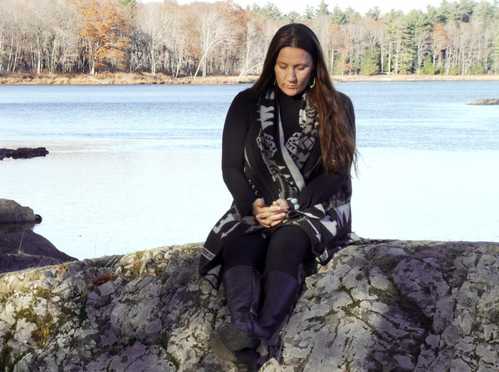Keywords: Wabanaki Indians
Item 80733
Egg Basket, Wabanaki, ca. 1900
Contributed by: Abbe Museum Date: circa 1900 Media: Ash splints, sweetgrass, dye
Item 80734
Comb basket, Wabanaki, ca. 1900
Contributed by: Abbe Museum Date: circa 1900 Media: Ash splints, sweetgrass, dye
Exhibit
Creation and other cultural tales are important to framing a culture's beliefs and values -- and passing those on. The Wabanaki -- Maliseet, Micmac, Passamaquoddy and Penobscot -- Indians of Maine and Nova Scotia tell stories of a cultural hero/creator, a giant who lived among them and who promised to return.
Exhibit
Holding up the Sky: Wabanaki people, culture, history, and art
Learn about Native diplomacy and obligation by exploring 13,000 years of Wabanaki residence in Maine through 17th century treaties, historic items, and contemporary artworks—from ash baskets to high fashion. Wabanaki voices contextualize present-day relevance and repercussions of 400 years of shared histories between Wabanakis and settlers to their region.
Site Page
"Wabanaki encampment, Bar Harbor, ca. 1890Abbe Museum In the olden days, from about 1860 to 1900, I well remember that Indian encampments were the…"
Site Page
Mount Desert Island: Shaped by Nature - The Indian Encampment
"The Indian Encampment Wabanaki family inside tent, Bar Harbor, ca. 1885Maine Historic Preservation Commission Rusticators were curious about…"
Story
A New Beginning for Wabanaki Land Relationships
by John Banks
Wabanaki leadership in land stewardship
Story
Wabanaki Fashion
by Decontie & Brown
Keeping the spirit and memories of our ancestors alive through fashion and creativity
Lesson Plan
Nation to Nation: Treaties and Legislation between the Wabanaki Nations and the State of Maine
Grade Level: 9-12
Content Area: Social Studies
This lesson plan asks high school students to think critically about and look closely at documentation regarding the Nation-to-Nation relationship between the Wabanaki Tribes/Nations and the State of Maine. This lesson asks students to participate in discussions about morality and legislative actions over time. Students will gain experience examining and responding to primary and secondary sources by taking a close look at documents relating to the Maine Indian Claims Settlement Act of 1980 (MICSA) and the issues that preceded and have followed the Act.
Lesson Plan
Grade Level: 3-5, 6-8, 9-12
Content Area: Science & Engineering, Social Studies
This lesson plan will give middle and high school students a broad overview of the ash tree population in North America, the Emerald Ash Borer (EAB) threatening it, and the importance of the ash tree to the Wabanaki people in Maine. Students will look at Wabanaki oral histories as well as the geological/glacial beginnings of the region we now know as Maine for a general understanding of how the ash tree came to be a significant part of Wabanaki cultural history and environmental history in Maine. Students will compare national measures to combat the EAB to the Wabanaki-led Ash Task Force’s approaches in Maine, will discuss the benefits and challenges of biological control of invasive species, the concept of climigration, the concepts of Traditional Ecological Knowledge (TEK) and Indigenous Knowledge (IK) and how research scientists arrive at best practices for aiding the environment.
















